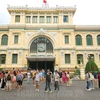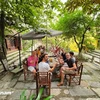 Two parallel rows of old Indochina Dragonplum trees on a yellow-leave-covered pavement of Phan Dinh Phung street. The road was named after a Vietnamese revolutionary from Ha Tinh province who was among the most prominent of the Confucian court scholars involved in anti-French military campaigns in the 19th century and was cited after his death by 20th-century nationalists as a national hero. Phan Dinh Phung, about 1.5 km in length stretching from Mai Xuan Thuong street to Hang Cot street, is home to a lot of historical buildings, including the beautiful Cua Bac Church. It is among those with the widest sidewalks in the capital, with its rows of trees giving shade and a lovely and tranquil scene. (Photo: VietnamPlus)
Two parallel rows of old Indochina Dragonplum trees on a yellow-leave-covered pavement of Phan Dinh Phung street. The road was named after a Vietnamese revolutionary from Ha Tinh province who was among the most prominent of the Confucian court scholars involved in anti-French military campaigns in the 19th century and was cited after his death by 20th-century nationalists as a national hero. Phan Dinh Phung, about 1.5 km in length stretching from Mai Xuan Thuong street to Hang Cot street, is home to a lot of historical buildings, including the beautiful Cua Bac Church. It is among those with the widest sidewalks in the capital, with its rows of trees giving shade and a lovely and tranquil scene. (Photo: VietnamPlus)  Yellow leaves scatter around big stumps of old deciduous Indochina Dragonplum trees (called “Sau” in Vietnamese), covering most parts of the payment. Despite its slow growth pace, the taproot tree is particularly suitable to urban areas for its strength against violent winds and big shadows year-round. The tree is a significant feature of Hanoi, planted on various streets across the city since the late 19th century. The fruit from its tiny white flowers is also widely loved by Hanoians, as it is the distinct ingredient for several local beloved dishes and drinks. It can be boiled in water morning glory vegetables to make a sour soup or processed into a kind of sweet syrup to drink with ice. (Photo: VietnamPlus)
Yellow leaves scatter around big stumps of old deciduous Indochina Dragonplum trees (called “Sau” in Vietnamese), covering most parts of the payment. Despite its slow growth pace, the taproot tree is particularly suitable to urban areas for its strength against violent winds and big shadows year-round. The tree is a significant feature of Hanoi, planted on various streets across the city since the late 19th century. The fruit from its tiny white flowers is also widely loved by Hanoians, as it is the distinct ingredient for several local beloved dishes and drinks. It can be boiled in water morning glory vegetables to make a sour soup or processed into a kind of sweet syrup to drink with ice. (Photo: VietnamPlus)  The combination of yellow colour of falling leaves and stained old walls make a picture of pure nostalgia. Scenes like this are a characteristic of Hanoi where the old and new merge together. That is why the city is dear to its residents and becomes a magnet to visitors. Hanoi has been emerging as a top destination for both domestic and foreign travellers in recent years, and it is still working to establish itself as a tourist hub. According to a survey conducted by municipal agencies, the average stay of foreign tourists in Hanoi rose from 3.64 days in 2017 to 3.67 days in 2018, and that of domestic travellers from 2.12 days to 2.32 days. (Photo: VietnamPlus)
The combination of yellow colour of falling leaves and stained old walls make a picture of pure nostalgia. Scenes like this are a characteristic of Hanoi where the old and new merge together. That is why the city is dear to its residents and becomes a magnet to visitors. Hanoi has been emerging as a top destination for both domestic and foreign travellers in recent years, and it is still working to establish itself as a tourist hub. According to a survey conducted by municipal agencies, the average stay of foreign tourists in Hanoi rose from 3.64 days in 2017 to 3.67 days in 2018, and that of domestic travellers from 2.12 days to 2.32 days. (Photo: VietnamPlus)  Autumn comes with gentle sunlight passing through the branches of tall old “sau” trees. Driving on the street during this time of the year is a wonderful experience. Hanoi in autumn has become a source of inspiration for generations of artists, including photographers, poets, writers and composers. The sweet autumn’s flavours, sights, sounds and smells are all memorable. The sky is blue, the sun gently warms the body instead of leaving you in a pool of sweat and the colours all around are vividly beautiful. The arrival of the year's best season almost feels like a reward for making it through the biting cold of winter, the wet and mouldy parts of spring and the oppressive heat of summer. (Photo: Vietnam Plus)
Autumn comes with gentle sunlight passing through the branches of tall old “sau” trees. Driving on the street during this time of the year is a wonderful experience. Hanoi in autumn has become a source of inspiration for generations of artists, including photographers, poets, writers and composers. The sweet autumn’s flavours, sights, sounds and smells are all memorable. The sky is blue, the sun gently warms the body instead of leaving you in a pool of sweat and the colours all around are vividly beautiful. The arrival of the year's best season almost feels like a reward for making it through the biting cold of winter, the wet and mouldy parts of spring and the oppressive heat of summer. (Photo: Vietnam Plus)  Once an emerging tourist destination, Hanoi saw its tourism hitting a slowdown this year after bearing the brunt of the COVID-19 pandemic. It welcomed just 6.29 million visitors in the first eight months, tumbling 67.3 percent year on year, with international arrivals down 75.6 percent to just 1.02 million. Such figures have resulted in a large number of local travel companies suspending operations while many hotels have shut their doors. With this latest outbreak being contained, industry insiders now look forward to improved business performance. There are only weeks left before Hanoi begins a wide range of large-scale activities to celebrate 1,010 years since it was established as Vietnam’s capital, called Thang Long at that time. (Photo: VietnamPlus)
Once an emerging tourist destination, Hanoi saw its tourism hitting a slowdown this year after bearing the brunt of the COVID-19 pandemic. It welcomed just 6.29 million visitors in the first eight months, tumbling 67.3 percent year on year, with international arrivals down 75.6 percent to just 1.02 million. Such figures have resulted in a large number of local travel companies suspending operations while many hotels have shut their doors. With this latest outbreak being contained, industry insiders now look forward to improved business performance. There are only weeks left before Hanoi begins a wide range of large-scale activities to celebrate 1,010 years since it was established as Vietnam’s capital, called Thang Long at that time. (Photo: VietnamPlus)  In a bid to revive the capital’s tourism sector, activities to mark the 1,010th anniversary of Thang Long – Hanoi cover a cultural week, a street festival, a craft village festival, a traditional boat race, a culinary festival, a calligraphy exhibition, and a dragon dance festival. This represents an opportunity to promote local tourism after its long hiatus. Many relic sites, places of interest, and entertainment venues have had their landscapes improved and new services opened to meet visitors’ demand. Local visitors are now believed to be the best target in plans to recover the tourism sector at this point of time. (Photo: VietnamPlus)
In a bid to revive the capital’s tourism sector, activities to mark the 1,010th anniversary of Thang Long – Hanoi cover a cultural week, a street festival, a craft village festival, a traditional boat race, a culinary festival, a calligraphy exhibition, and a dragon dance festival. This represents an opportunity to promote local tourism after its long hiatus. Many relic sites, places of interest, and entertainment venues have had their landscapes improved and new services opened to meet visitors’ demand. Local visitors are now believed to be the best target in plans to recover the tourism sector at this point of time. (Photo: VietnamPlus)  A street full of falling leaves offer the best scene for people to leave their house for a stroll. Phan Dinh Phung’s pavements are perfect for pedestrians. They are among the widest sidewalks in the capital, with the famous three rows of “sau” trees giving shade all year round and a lovely and tranquil scene. Named after a Vietnamese revolutionary from Ha Tinh province who was among the most prominent of the Confucian court scholars involved in anti-French military campaigns in the 19th century, Phan Dinh Phung street is about 1.5 km in length stretching from Mai Xuan Thuong street to Hang Cot street. (Photo: Vietnam Plus)
A street full of falling leaves offer the best scene for people to leave their house for a stroll. Phan Dinh Phung’s pavements are perfect for pedestrians. They are among the widest sidewalks in the capital, with the famous three rows of “sau” trees giving shade all year round and a lovely and tranquil scene. Named after a Vietnamese revolutionary from Ha Tinh province who was among the most prominent of the Confucian court scholars involved in anti-French military campaigns in the 19th century, Phan Dinh Phung street is about 1.5 km in length stretching from Mai Xuan Thuong street to Hang Cot street. (Photo: Vietnam Plus)  A young girl is posing for a picture on the backdrop of the pavement covered by falling yellow leaves. Phan Dinh Phung street’s pavements are also a popular place for young Vietnamese to check in. Their various corners can be easily found in photos published on several local Instagram and Facebook pages. Phan Dinh Phung street, named after a Vietnamese revolutionary from Ha Tinh province who was involved in anti-French military campaigns in the 19th century, is about 1.5 km in length, stretching from Mai Xuan Thuong street to Hang Cot street. Its pavements are among the widest sidewalks in the capital, with their famous rows of “sau” trees giving shade all year round and a lovely and tranquil scene. (Photo: VietnamPlus)
A young girl is posing for a picture on the backdrop of the pavement covered by falling yellow leaves. Phan Dinh Phung street’s pavements are also a popular place for young Vietnamese to check in. Their various corners can be easily found in photos published on several local Instagram and Facebook pages. Phan Dinh Phung street, named after a Vietnamese revolutionary from Ha Tinh province who was involved in anti-French military campaigns in the 19th century, is about 1.5 km in length, stretching from Mai Xuan Thuong street to Hang Cot street. Its pavements are among the widest sidewalks in the capital, with their famous rows of “sau” trees giving shade all year round and a lovely and tranquil scene. (Photo: VietnamPlus)  A young girl in ao dai taking photo on Phan Dinh Phung street. The ao dai, Vietnam’s national dress, features a slim-fitting tunic with long side splits from the waist, worn over palazzo-style trousers. The costume, a delicate and airy garment, has been mentioned in many poems, stories and songs for centuries. It is considered by Westerners to be one of the most elegant and feminine national costumes in the world with its close-fitting bodice, free-flowing front and back panels, and long silk trousers. Though Vietnam’s famous traditional dress has taken many forms over the centuries, its allure and appeal remain a timeless trend. (Photo: VietnamPlus)
A young girl in ao dai taking photo on Phan Dinh Phung street. The ao dai, Vietnam’s national dress, features a slim-fitting tunic with long side splits from the waist, worn over palazzo-style trousers. The costume, a delicate and airy garment, has been mentioned in many poems, stories and songs for centuries. It is considered by Westerners to be one of the most elegant and feminine national costumes in the world with its close-fitting bodice, free-flowing front and back panels, and long silk trousers. Though Vietnam’s famous traditional dress has taken many forms over the centuries, its allure and appeal remain a timeless trend. (Photo: VietnamPlus)  A tranquil corner of Phan Dinh Phung street. The street has long been famous for its green, quite space and much less traffic. Phan Dinh Phung’s pavements are perfect for pedestrians. They are among the widest sidewalks in the capital, with their famous three rows of giant old “sau” trees giving shade all year round and creating a lovely and tranquil scene. Named after a Vietnamese revolutionary from Ha Tinh province who involved in anti-French military campaigns in the 19th century, Phan Dinh Phung street is about 1.5 km in length, stretching from Mai Xuan Thuong street to Hang Cot street. (Photo: VietnamPlus)
A tranquil corner of Phan Dinh Phung street. The street has long been famous for its green, quite space and much less traffic. Phan Dinh Phung’s pavements are perfect for pedestrians. They are among the widest sidewalks in the capital, with their famous three rows of giant old “sau” trees giving shade all year round and creating a lovely and tranquil scene. Named after a Vietnamese revolutionary from Ha Tinh province who involved in anti-French military campaigns in the 19th century, Phan Dinh Phung street is about 1.5 km in length, stretching from Mai Xuan Thuong street to Hang Cot street. (Photo: VietnamPlus)  Gazing at the street these days, people are often astonished by its beauty, which is enhanced by the touch of autumn that makes leaves fall. Autumn is agreed by many as the best time of the year in the capital city. It has become a source of inspiration for Vietnamese artists. The sweet autumn’s flavours, sights, sounds and smells are all memorable. The sky is blue, the sun gently warms the body instead of leaving you in a pool of sweat and the colours all around are vividly beautiful. The arrival of the year's best season almost feels like a reward for making it through the biting cold of winter, the wet and mouldy parts of spring and the oppressive heat of summer. (Photo: VietnamPlus)
Gazing at the street these days, people are often astonished by its beauty, which is enhanced by the touch of autumn that makes leaves fall. Autumn is agreed by many as the best time of the year in the capital city. It has become a source of inspiration for Vietnamese artists. The sweet autumn’s flavours, sights, sounds and smells are all memorable. The sky is blue, the sun gently warms the body instead of leaving you in a pool of sweat and the colours all around are vividly beautiful. The arrival of the year's best season almost feels like a reward for making it through the biting cold of winter, the wet and mouldy parts of spring and the oppressive heat of summer. (Photo: VietnamPlus) VNA



















